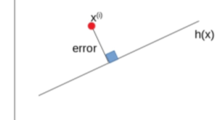
Overview
- Offers frequent opportunities to practice techniques with control questions, exercises, thought experiments, and computer assignments.
- Reinforces principles using well-selected toy domains and relevant real-world applications.
- Provides additional material, including an instructor's manual with presentation slides, as well as answers to exercises.
- Includes supplementary material: sn.pub/extras
- Request lecturer material: sn.pub/lecturer-material
Access this book
Tax calculation will be finalised at checkout
Other ways to access
About this book
This textbook presents fundamental machine learning concepts in an easy to understand manner by providing practical advice, using straightforward examples, and offering engaging discussions of relevant applications. The main topics include Bayesian classifiers, nearest-neighbor classifiers, linear and polynomial classifiers, decision trees, neural networks, and support vector machines. Later chapters show how to combine these simple tools by way of “boosting,” how to exploit them in more complicated domains, and how to deal with diverse advanced practical issues. One chapter is dedicated to the popular genetic algorithms.
This revised edition contains three entirely new chapters on critical topics regarding the pragmatic application of machine learning in industry. The chapters examine multi-label domains, unsupervised learning and its use in deep learning, and logical approaches to induction. Numerous chapters have been expanded, and the presentation of the material has been enhanced. The book contains many new exercises, numerous solved examples, thought-provoking experiments, and computer assignments for independent work.
Similar content being viewed by others
Keywords
- Bayesian classifiers
- boosting
- computational learning theory
- decision trees
- genetic algorithms
- linear and polynomial classifiers
- nearest neighbor classifier
- neural networks
- performance evaluation
- reinforcement learning
- statistical learning
- time-varying classes, imbalanced representation
- artificial intelligence
- machine learning
- data mining
- deep learning
- unsupervised learning
Table of contents (17 chapters)
-
Front Matter
-
Back Matter
Reviews
“This book describes ongoing human-computer interaction (HCI) research and practical applications. … These techniques can be very useful in AR/VR development projects, and some of these chapters can be used as examples and guides for future research.” (Miguel A. Garcia-Ruiz, Computing Reviews, January, 2019)
Authors and Affiliations
About the author
Miroslav Kubat, Associate Professor at the University of Miami, has been teaching and studying machine learning for over 25 years. He has published more than 100 peer-reviewed papers, co-edited two books, served on the program committees of over 60 conferences and workshops, and is an editorial board member of three scientific journals. He is widely credited with co-pioneering research in two major branches of the discipline: induction of time-varying concepts and learning from imbalanced training sets. He also contributed to research in induction from multi-label examples, induction of hierarchically organized classes, genetic algorithms, and initialization of neural networks.
Bibliographic Information
Book Title: An Introduction to Machine Learning
Authors: Miroslav Kubat
DOI: https://doi.org/10.1007/978-3-319-63913-0
Publisher: Springer Cham
eBook Packages: Computer Science, Computer Science (R0)
Copyright Information: Springer International Publishing AG 2017
Softcover ISBN: 978-3-319-87669-6Published: 18 August 2018
eBook ISBN: 978-3-319-63913-0Published: 31 August 2017
Edition Number: 2
Number of Pages: XIII, 348
Number of Illustrations: 82 b/w illustrations, 3 illustrations in colour
Topics: Data Mining and Knowledge Discovery, Artificial Intelligence, Big Data/Analytics, Computational Intelligence



